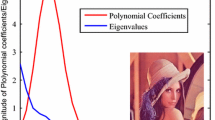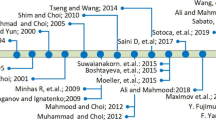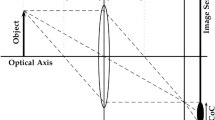Abstract
Discrete Cosine Transform (DCT) and Principal Component Analysis (PCA) are widely used in computer vision applications. In this paper, we introduce a new SFF method based on DCT and PCA. Contrary to computing focus quality locally by summing all values in a 2D or 3D window obtained after applying a focus measure, a vector consisting of seven neighboring pixels is populated for each pixel in the image volume. PCA is applied on the AC part of the DCT of each vector in the sequence to transform data into eigenspace. Considering the first feature, as it contains maximum variation, and discarding all others, is employed to compute the depth. Though DCT and PCA are both computationally expensive transformations, the reduction in data elements and algorithm iterations have made the new approach efficient. Experimental results are presented to demonstrate the effectiveness of new method by using three different image sequences.
Preview
Unable to display preview. Download preview PDF.
Similar content being viewed by others
References
Bilal, A.M., Choi, T.S.: A Heuristic approach for finding best focused shape. IEEE Transactions on Circuits and Systems for Video Technology 15(4), 566–574 (2005)
Malik, A.S., Choi, T.S.: Application of Passive Techniques for Three Dimensional Cameras. IEEE Trans. Consumer Electronics 53(2) (2007)
Krotkov, E.: Focusing. Int. J. Computer Vision 1, 223–237 (1987)
Malik, A.S., Choi, T.S.: Consideration of illumination effects and optimization of window size for accurate calculation of depth map for 3D shape recovery. Pattern Recognition 40(1), 154–170 (2007)
Ahmad, M.B., Choi, T.S.: Shape from Focus using Optimization Technique. In: Proc. IEEE, Int. Conf. on Acoustics, Speech, and Signal Processing, vol. 2, pp. 493–496 (2006)
Ahmad, M.B., Choi, T.S.: Application of Three Dimensional Shape from Image Focus in LCD/TFT Displays Manufacturing. IEEE Trans. Consumer Electronics 53(1), 1–4 (2007)
Helmli, F.S., Scherer, S.: Adaptive Shape from Focus with an Error Estimation in Light Microscopy. In: 2nd Int’l Symposium on Image and Signal Processing and Analysis (ISPA 2001) (2001)
Sun,, Stefan, Y.D., Nelson Bradley, J.: Autofocusing in computer microscopy: Selecting the optimal focus algorithm. Microscopy Research and Technique 65(3), 139–149 (2004)
Nayar, S.K., Nakagawa, Y.: Shape from focus. IEEE Trans. Pattern Anal. Mach. Intell 16(8), 824–831 (1994)
Baina, J., Dublet, J.: Automatic focus and iris control for video cameras. In: IEEE Fifth International Conference on Image Processing and its Applications, pp. 232–235 (1995)
Chun-Hung, S., Chen, H.H.: Robust focus measure for low-contrast images. In: International Conference on Consumer Electronics ICCE 2006. Digest of Technical Papers, pp. 69–70 (2006)
Lee, S.Y., Park, S.S., Kim, C.S., Kumar, Y., Kim, S.W.: Low-power auto focus algorithm using modified DCT for the mobile phones. In: International Conference on Consumer Electronics ICCE 2006. Digest of Technical Papers, pp. 67–68 (2006)
Kristan, M., Perse, P.J., Kovacic, S.M.: A Bayes-spectral-entropy-based measure of camera focus using a discrete cosine transform. Pattern Recognition Letters 27(13), 1431–1439 (2006)
Subbarao, M., Choi, T.S.: Accurate recovery of three dimensional shape from image focus. IEEE Trans. Pattern Anal. Mach. Intell 17(3), 266–274 (1995)
Yun, J., Choi, T.S.: Accurate 3-D shape recovery using curved window focus measure. In: ICIP 1999, vol. 3, pp. 910–914 (1999)
Asif, M., Choi, T.S.: Shape from focus using multilayer feedforward neural network. IEEE Trans. Image Process. 10(11), 1670–1675 (2001)
Ahmed, N., Natarajan, T., Rao, K.R.: Discrete Cosine Transform. IEEE Transactions on Computers C-23(1), 90–93 (1974)
Schölkopf, B., Smola, A.: Learning with Kernels. MIT Press, Cambridge (2002)
Yang, G., Nelson, B.J.: Wavelet-based autofocusing and unsupervised segmentation of microscopic images. In: IEEE/RSJ International Conference on Intelligent Robots and Systems (IROS), vol. 3, pp. 2143–2148 (2003)
Subbarao, M., Tyan, J.K.: Selecting the optimal focus measure for autofocusing and depth-from-focus. IEEE Trans. Pattern Anal. Mach. Intell. 20(8), 864–870 (1998)
Author information
Authors and Affiliations
Editor information
Rights and permissions
Copyright information
© 2008 Springer-Verlag Berlin Heidelberg
About this paper
Cite this paper
Mahmood, M.T., Choi, WJ., Choi, TS. (2008). DCT and PCA Based Method for Shape from Focus. In: Gervasi, O., Murgante, B., Laganà, A., Taniar, D., Mun, Y., Gavrilova, M.L. (eds) Computational Science and Its Applications – ICCSA 2008. ICCSA 2008. Lecture Notes in Computer Science, vol 5073. Springer, Berlin, Heidelberg. https://doi.org/10.1007/978-3-540-69848-7_81
Download citation
DOI: https://doi.org/10.1007/978-3-540-69848-7_81
Publisher Name: Springer, Berlin, Heidelberg
Print ISBN: 978-3-540-69840-1
Online ISBN: 978-3-540-69848-7
eBook Packages: Computer ScienceComputer Science (R0)




